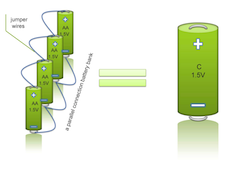A typical flashlight holds two or three cells (batteries). When these cells are placed in series or a stack, the voltage increases. For instance, a 1.5V battery flashlight: when two cells are placed in series, the voltage increases to 3V (1.5V + 1.5V).
A brightly-lit 1.5V light bulb will burn out quickly because the higher voltage (or pressure) pushes more current through the circuit than the bulb is designed to handle. Similarly, when the cell voltage is lower than the bulb’s rating, the bulb is dimly lit as there is insufficient current flowing through the circuit. This is what happens when your flashlight batteries run low: there are not enough electrons flowing in the batteries. On your next visit to the grocery store, check out their battery display. You will find a wide selection that usually includes AA, AAA, C and D types, all with the same 1.5V rating. What is the difference between them? Quite simply, there are more electrons in a bigger cell than in a smaller one. More electrons mean a bigger flow to power an electrical load longer.
The image shows jumper wires linking cells in parallel. A parallel arrangement ensures that a battery bank of 4 AA-size cells offers the same number of electrons as a C-sized cell. A battery bank is a grouping of cells in series, parallel or a combination of connections.
Obviously, a typical home needs much more electricity than a simple flashlight. Off-grid homes generate electricity using renewable sources and store the excess in battery banks. Each battery cell carries a nominal 2V voltage, with a positive (+) and a negative (-) terminal. Each terminal is wired in series to the next cell to increase the overall voltage of the battery bank. Thus, a 12-cell series strung together gives a battery bank of 24V DC (12 cells, each of 2V).
